Crocus, like snowdrop, is a harbinger of spring, which pleases the grower with its flowering after the snow cover has melted. There are other varieties that bloom by mid-summer. Autumn crocus planting helps to get a grateful flowering in spring. During the winter, the bulb accumulates nutrients and is saturated with moisture. Plants in which flowering occurs in the summer, it is better to plant in the spring, because these varieties do not differ in frost resistance.
Content
- 1 Crocus varieties for planting in the fall
- 2 Preparation of land for crocus planting in autumn
- 3 Preparation and storage of tubers before planting in autumn
- 4 Landing of crocuses in the fall in the ground
- 5 Features of crocus planting by region
- 6 Crocus Care in Autumn
- 7 Crocus transplant in the fall to another place
- 8 How to store crocuses before planting in the fall
- 9 Crocus propagation
- 10 Digging and storing autumn crocus bulbs for planting
- 11 Crocus Diseases and Pests
- 12 When to plant crocuses in autumn or spring
- 13 Finally
Crocus varieties for planting in the fall
Crocus is also called "spring saffron", it is used to decorate flower beds in summer cottages. Often used to create green slides. A bulbous plant is not demanding in care. In the fall, crocuses are planted in open ground, and care ends until spring - the grower just needs to wait for the shoots and the appearance of peduncles.
It is not possible to achieve flowering in early spring from all varieties. Early flowering varieties are:
- Spring crocus. Like other varieties - a herbaceous plant with a stem length of about 15 cm. The flower has a funnel shape, is painted in purple or white, the anther is yellow. The adult bulb is updated annually, reproduces no more than 3 peduncles during the growing season. The following varieties belong to this species: Nigro Boy, Pikvik, Remeberans, Stoustor.
- Golden flowered. The plant is about 20 cm long; a yellow flower appears before narrow, bright green leaves. Bulb pressed down, spherical in shape. The view includes the following varieties: Blue Pearl, Lady Killer, Snowbunting, Blue Bonet.
- Geifel's Crocus. Plants differ in such varietal characteristics: a round bulb, linear leaves with curled edges, purple or white petals. These varieties are valued for continuous (more than 25 days) flowering. The group includes: Oksonion, Bagila, Albus, Artabir.
- Tomasini. Varietal traits: a low plant up to 8 cm tall, narrow leaves, a large flower of purple, white or lilac color. It is an industrial variety and does not represent value to collectors. Often used for landscaping city parks, flower beds. Varieties: Lilac beauty, Rossi, Purple giant.
These crocuses can be planted in autumn, unlike late-flowering varieties. Despite the fact that the plant is not demanding, for good flowering it is necessary to provide it with good conditions and proper planting.
Preparation of land for crocus planting in autumn
The main condition for the beneficial growth and lush flowering is sunlight, so you do not need to plant bulbs under the shade of trees or shrubs, they need to select the most illuminated area on the site. The body of the bulb is sensitive to moisture, because the overflow is destructive, the plant responds well to fertilizing and grows in light soil.
You can get rid of stagnation of excess fluid by providing drainage. It is made of coarse sand, gravel or expanded clay, laying such a substrate to a planting depth of up to 25 cm. Air exchange can be done by digging the ground with river sand and any mineral component, for example, manure, humus or compost. In an acidic environment, a bulbous plant will quickly die, therefore it is necessary to neutralize the acid with a mixture of lime and peat. Experienced flower growers know how to plant crocuses in the fall in order to preserve the tuber and get a beautiful flowering.
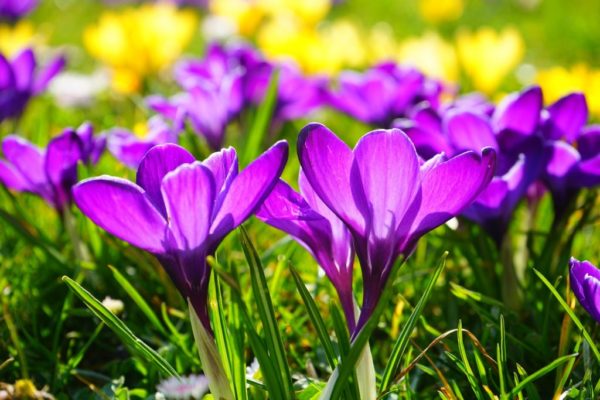
Preparation and storage of tubers before planting in autumn
Crocuses are recommended to be transplanted once every 3-4 years. This must be done in order to detach the children from the overgrown bulb, pruning the sick, damaged areas and fully treat the underground part.Early flowering plants complete their growing season in July. This is expressed in the death of the aerial parts of the plant and immersion in a state of rest. This is expressed in the rapid drying of the green part of the plant. Inexperienced flower growers may think that the crocus is gone, but the flower just goes to bed early.
After the completion of the vegetative cycle, the bulb is dug out of the soil in dry weather. All roots are removed, dried in the fresh air and sorted by removing affected bulbs. Children can be set aside for growing and planted in pots in the spring.
Store prepared material in a dry place at room temperature. It is better to lay the bulbs in layers in a wooden box, laying each layer with sawdust or wrap in soft toilet paper.
Landing of crocuses in the fall in the ground
Landing begins with the selection of a suitable location. Ideally, it should be well lit and moderately humid. No need to plant flowers in the ground after tomatoes or potatoes - these crops draw all the nutrients from the soil.
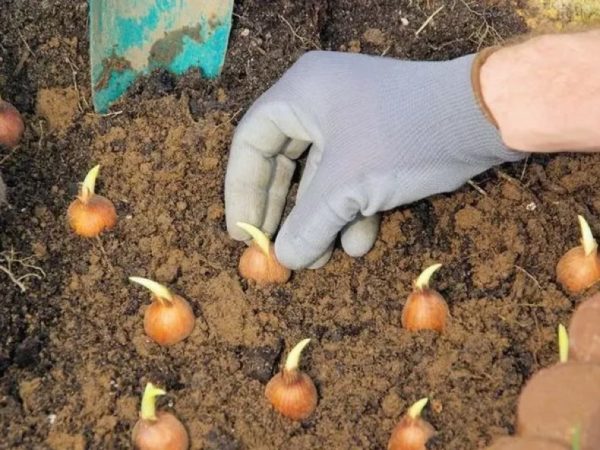
Crocus planting dates
Planting dates of any plant is a conditional concept, which varies depending on the region. It takes about 2-3 weeks to take root in small bulbs. Exposure to the sun and heat during this period is not required; it is important to prevent the drying of the earth coma.
Early planting in the fall is dangerous for the bulb, because it can germinate. If a sprout with greens comes to the surface, after the onset of frost, the plant is likely to die.
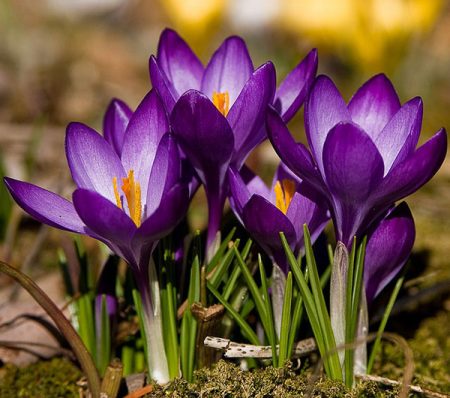 You may be interested in:
You may be interested in:Crocus soil
The soil is dug up to a depth of 20 cm, the excess roots of weeds and garbage scavenged. On a plot of 1 square meter you need to make:
- 5 kg of sand;
- compost or humus 5 kg;
- ash 300 g;
- potassium salts of 30 g;
- superphosphate 50 g
If the clay soil, perlite is additionally introduced.
Preparing planting material
A healthy onion meets these qualities:
- dense;
- heavy
- has dry scales;
- size - 3-8 cm in diameter.
Of course, traces of decay, mechanical damage or the presence of pest activity products indicate the unsuitability of the material for planting.
Qualitative material before planting is treated with a solution of manganese potassium or Fundazole.For this, onions are enough to soak in the finished solution for several hours.
Unsuitable for planting in the winter:
- bulbs with a size of up to 3 cm are children who will not survive the frost;
- a plant with an awakened sprout.
Children and bulbs with sprouted herbs are planted in bowls in autumn and placed in a cellar or cellar until spring. You can plant them in open ground in the spring, but the kids will not give flowering.
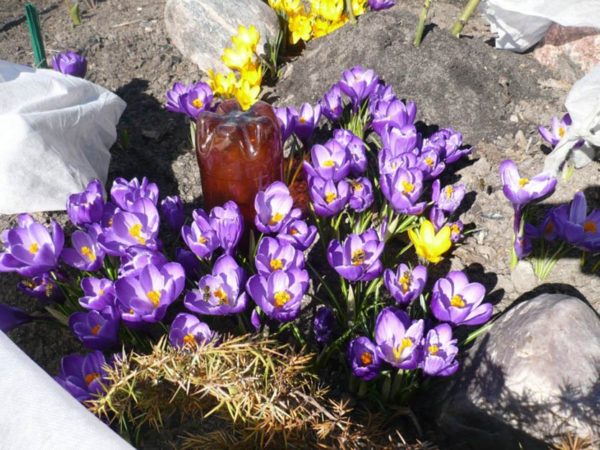
At what depth should crocuses be planted?
Small bulb plants are recommended to be planted in groups. The bulbs have longitudinal glades with a spacing of 4-5 cm between rows. For the convenience of collecting planting material, gardeners bury them together with a special bowl. It needs to make drainage holes of an impressive size. Bulb close up to a depth of 8-12 cm, depending on the type of soil.
Landing pattern
They should be placed in a group, so that after the dissolution of the buds to receive lush flowering. One tuber requires an area of 15 * 15 cm square. It is recommended to deepen the root by 5-12 cm, depending on the size of the tuber and the quality of the soil. If the soil is loose, optimally deepen by 8-12 cm, planted in solid soil to a depth of 7 cm.
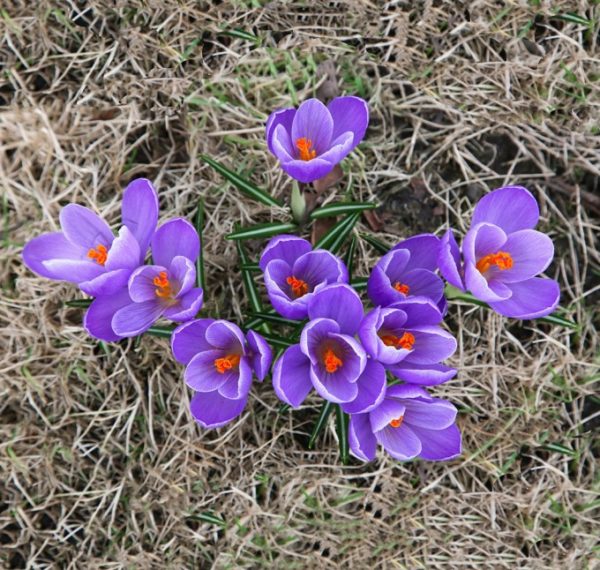
Ground insulation
Special insulation for wintering crocuses after planting in the fall is not required. The plant normally tolerates small frosts, the bulb survives even with icing of the soil surface. There is a risk of losing the plant in such cases:
- bulb - baby, has a small diameter;
- the plant is affected by rot;
- planting material is placed in excessively moist soil;
- a small onion embedded in the soil to a minimum depth.
The consequences of death can be avoided by mulching. It is recommended that any improvised organic material be poured onto the soil. If small bulbs are planted in the ground, you can additionally cover them with dry branches or burlap. Waste in the form of plant tops is not used as material for mulching. Often they are a source of bacteria and fungus.
Features of crocus planting by region
The gardener should record in the notebook the timing of the arrival of cold weather and thaws in his own region. Having received statistics for several years, you can determine the most favorable terms for planting the material.
In the middle zone of Russia, in the Moscow region, the Leningrad region and Ukraine, the bulbs are planted in open ground at the beginning of October. If the weather in September is cool. Landing can be done earlier. In southern Russia, crocuses are planted in open ground at the end of October. Early planting can cause premature germination, the culture does not need additional warming.
Winters are harsher in Siberia and the Urals, and autumn is very short. Therefore, it is better to plant bulbs in open ground in September, without waiting for the first frosts. The tuber should be deepened as much as possible and additionally cover the surface with spruce branches or sawdust. If weather forecasters promise an abnormally cold winter, you should not plant a plant under winter in this region.
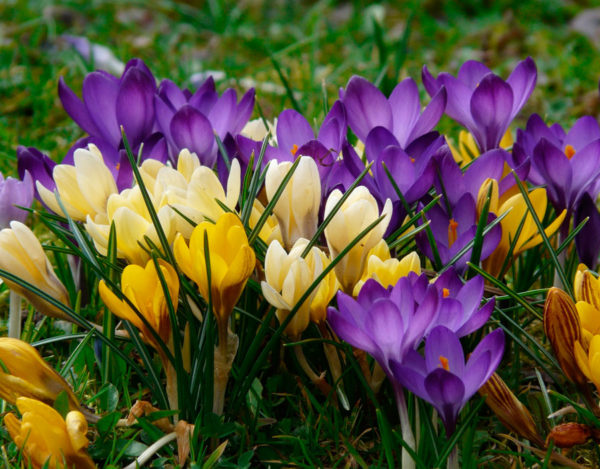
Crocus Care in Autumn
A plant that blooms in spring and ends its vegetative cycle in autumn. Top dressing is stopped in May, and the bulb leaves on its own at rest in late summer. After dying off the green part, it is dug up, cleaned of soil residues and dried in the sun.
The main stage of crocus care in the fall is planting the plant back in the open ground. To do this, you need to revise the planting material and drop it in compliance with the recommended scheme. Watering the soil additionally is not required. Fertilizer and baking powder, perlite are introduced into the soil.
Autumn crocus care
After flowering, crocus can not be dug up, especially if the plant is young.A bulb without loss of its qualities can live in open ground without transplant for about 5 years. After the completion of the vegetative cycle, the plant is not fertilized; it prepares for rest in the winter. Watering is provided additionally if autumn passes without rains. After the decay of the deciduous part, it is cut off and the soil is sprinkled with an additional layer of peat.
Crocus care in winter
In winter, the plant does not require care. If the soil surface is covered with material, then during the thaw period, you need to remember about ventilation. Excessive insulation can cause excess moisture, which crocus does not like.
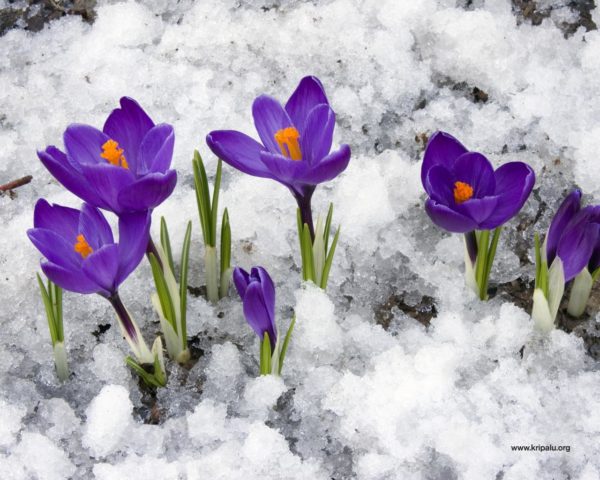
Crocus transplant in the fall to another place
Adult crocuses are best transplanted once every two years, because the supply of nutrients in the soil, despite the application of fertilizers, is depleted. It is unacceptable to plant the bulb in the soil where tomatoes, cabbage or potatoes grew. Before planting, the soil is carefully examined for debris and pests. If necessary, carry out processing.
Plants are planted in dry soil and do not spill it additionally. After transplanting, the bulbs do not need additional care. The scheme of events is no different.
How to store crocuses before planting in the fall
Planting material after digging is stored in a dry, ventilated area with optimal humidity. The temperature regime does not matter. It is not recommended to use plastic bags for storage, because the plant will rot, and this will provoke rot.
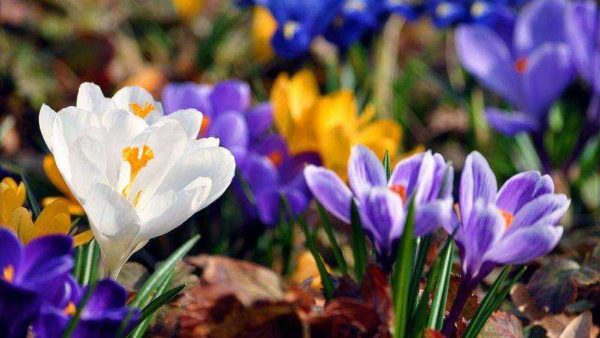
Crocus propagation
The flower can be propagated by bulbs and seeds. Bulb propagation method - the fastest, separated plant is able to bloom after the diameter of the tuber reaches a size of 3-4 cm, i.e. for 2 years. Propagation by seeds is a long process, after collection they are dried, sorted and stored until planting in a well-ventilated area. Sown in the spring and provide a full light mode and sufficient heat. The bulb forms slowly and blooms for 4 years.
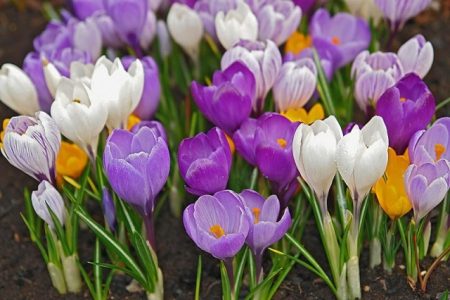 You may be interested in:
You may be interested in:Digging and storing autumn crocus bulbs for planting
Autumn crocus must be dug from the ground before the onset of frost, after the completion of the entire vegetative cycle. Often the aboveground green part does not have time to retire by this time, because it is removed with scissors. All bulbs should be inspected for rot, pests and mechanical damage.
The collected planting material is best stored in special boxes made of chipboard or wood. Bulbs are laid in one layer and sprinkled with sawdust, after such insulation, you can lay the next layer. You can store plants in the basement or cellar.
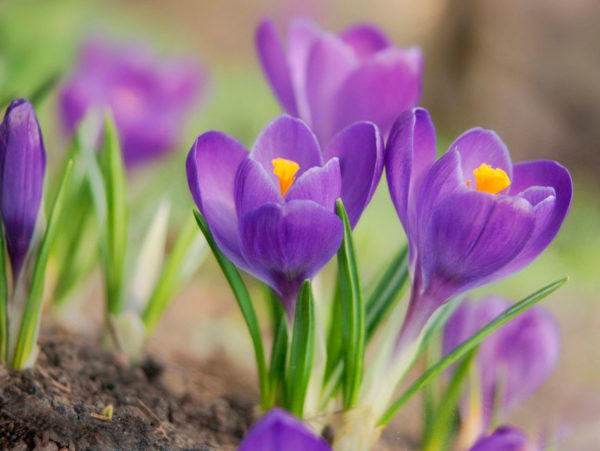
Crocus Diseases and Pests
Crocus is affected by such pests and diseases:
- mice
- scoops;
- wireworm;
- aphid;
- rot.
The corm is affected by fungal and bacterial diseases.
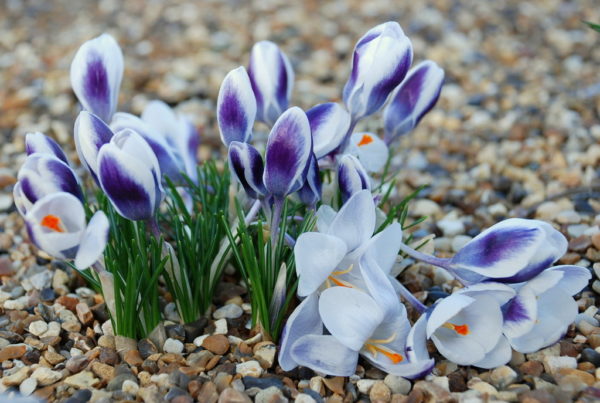
When to plant crocuses in autumn or spring
Varieties that bloom in early spring are planted in the ground in autumn, before frost. Species blooming in autumn are recommended to be planted no earlier than May. These plants do not tolerate frost and do not winter in the exhaust gas. For planting, choose a well-lit area and provide removal of excess moisture.
Finally
Crocus is an unpretentious plant, a harbinger of spring. Depending on the variety, the flowering plant has a white, purple, blue or yellow color - this variety will decorate the flowerbed in early spring, when nature is just beginning to recover from winter. Planting a crocus in the fall will help to obtain abundant flowering in the spring, and the tips given will help make the winter comfortable for the bulb. You need to properly plant and take good care of the plant, then it will give the grower a spring riot of colors.

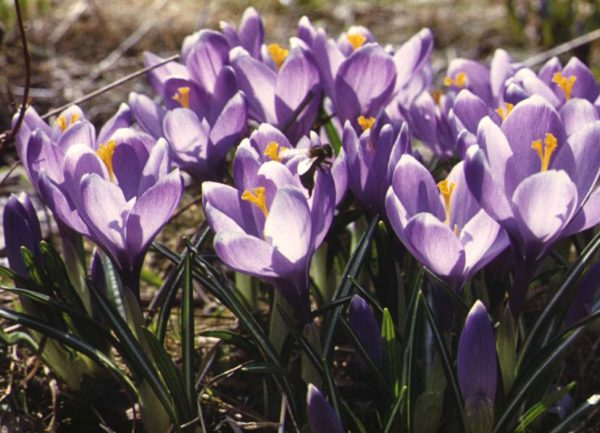
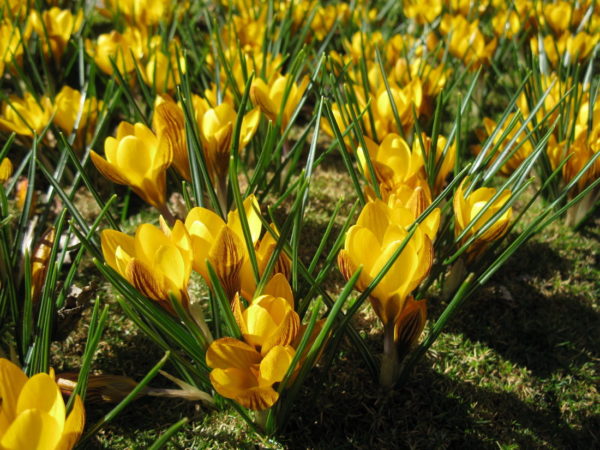
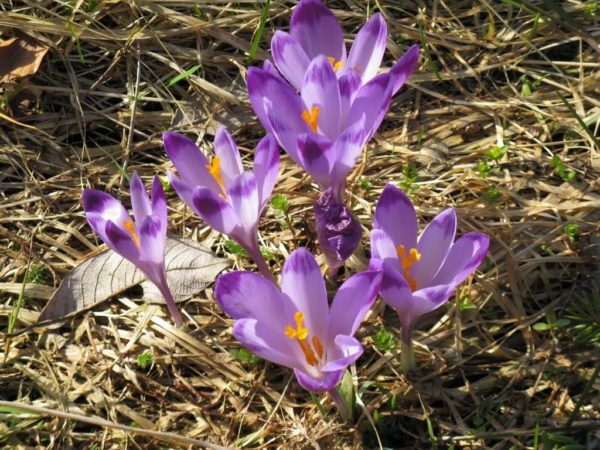
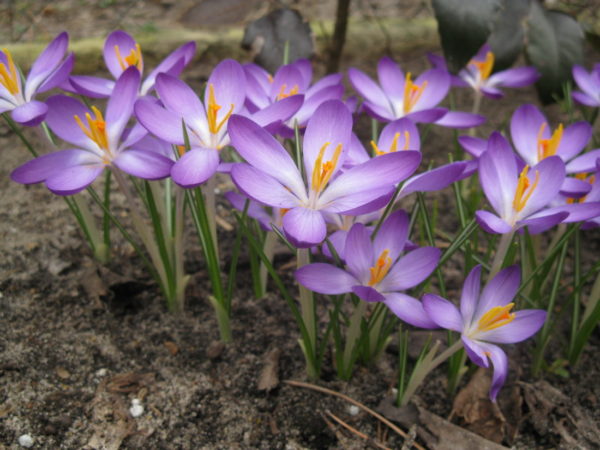
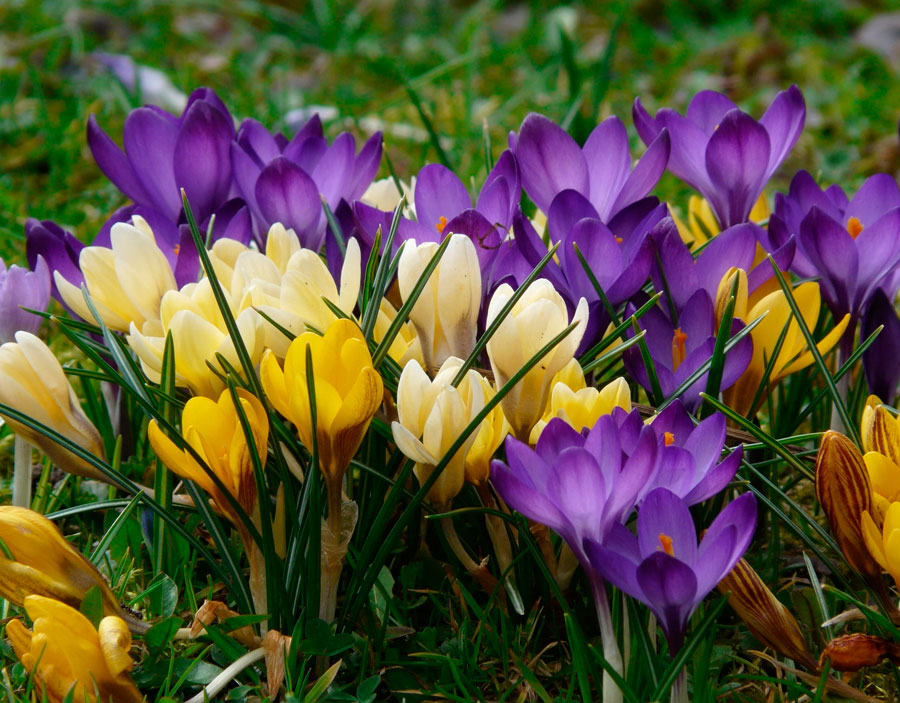

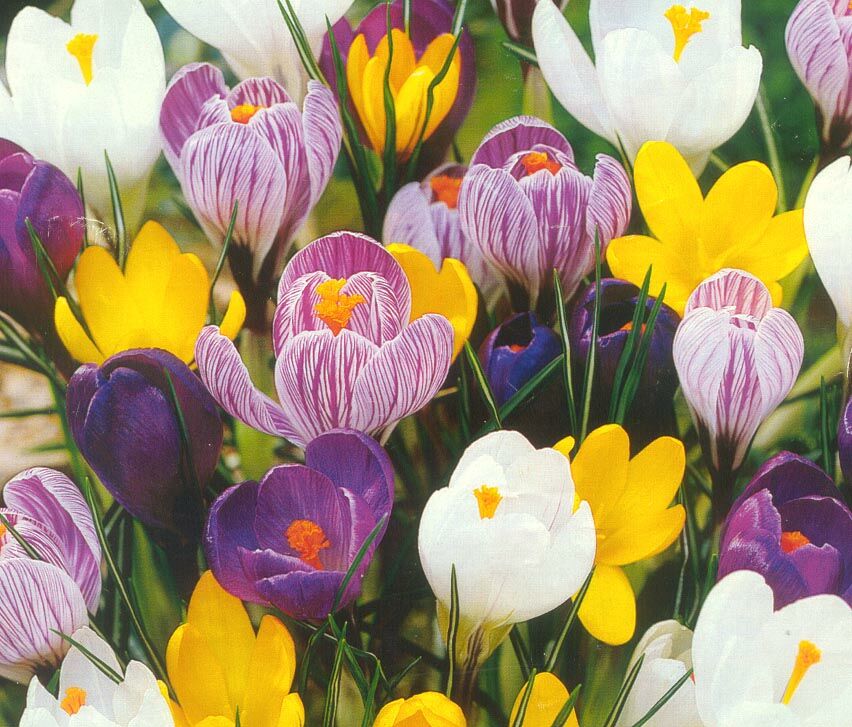
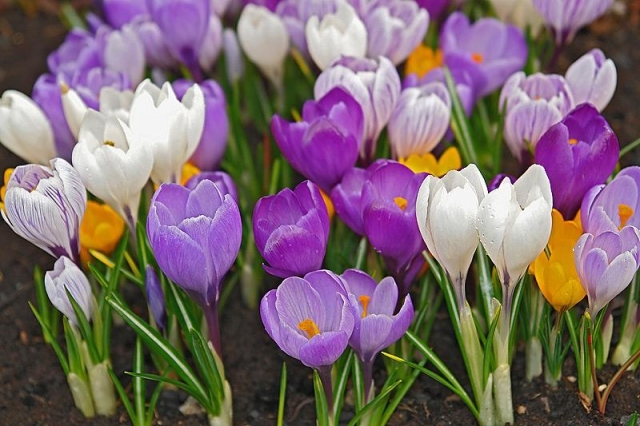 Do I need to dig crocuses after flowering?
Do I need to dig crocuses after flowering?